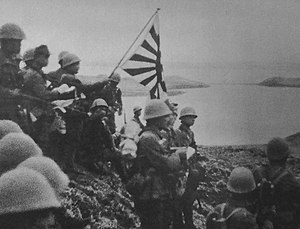Template:Fix bunching
Template:Fix bunching
Template:Fix bunching
Template:Fix bunching
The Japanese occupation of Kiska took place between June 6, 1942 and July 28, 1943 during the Aleutian Islands Campaign of the Pacific War in World War II. The Japanese occupied Kiska and nearby Attu Island in order to protect the northern flank of the Japanese Empire.
Occupation
Initially, the only American military presence on Kiska was a ten-man weather station. The Japanese stormed the station, killing two Americans and capturing the remaining eight. The eight prisoners of war were sent to Japan.
The attack on Pearl Harbor and beginning of the Pacific Theatre in World War II, coupled with Japanese threats to the west coast of North America and the Aleutian Islands, had already made the construction of a defense access highway to Alaska a priority. On February 6, 1942 the construction of the Alaska Highway was approved by the United States Army and the project received the authorization from the U.S. Congress and President Franklin D. Roosevelt to proceed five days later.
Reacting to the Japanese occupation, American and Canadian air forces waged a continuous air bombardment campaign against the Japanese forces on Kiska. Also, United States Navy warships blockaded and periodically bombarded the island. Several Japanese warships, transport ships, and submarines attempting to travel to Kiska or Attu were sunk or damaged by the blockading forces.
In May 1943, United States forces landed on and destroyed the Japanese garrison on Attu. In response, the Imperial Japanese Navy successfully evacuated the Kiska garrison on July 28, 1943, ending the Japanese presence in the Aleutian Islands. Not completely sure that the Japanese were gone, the Americans and Canadaians executed an unopposed landing on Kiska on August 15, 1943, securing the island and ending the Aleutian Islands campaign.
Naval operations
On June 19, 1942, American aircraft attacked and sank the Japanese oiler Nissan Maru in Kiska Harbor and on June 30, American naval forces bombarded Kiska. The submarine USS Growler attacked and sank one Japanese destroyer seven miles east of the harbor on July 5. Two other destroyers were also heavily damaged. Over 200 Japanese sailors were killed or wounded while the Americans sustained no losses, it became the single bloodiest engagement during the operations on and around Kiska. USS Grunion was attacked by three Japanese submarine chasers while patrolling Kiska Harbor on July 15. In response she fired on and sank two of the Japanese ships and damaged the third. The Grunion was lost a few days later off Kiska on July 30 with all hands. She was suspected of being sunk by a sea mine.
On August 8, Japanese cargo ship Kano Maru was sunk at Kiska Harbor by PBY Catalinas. Days before, the cargo ship was damaged by one of the Grunion's torpedos. Troopship Nozima Maru was also bombed and sunk in Kiska Harbor on September 15. On October 5, the Japanese steamer Borneo Maru was sunk at Gertrude Cove and on October 17, the destroyer Oboro was sunk by American aircraft. Japanese submarine RO-65 sank off Kiska on November 4, Montreal Maru on January 5, 1943, and Uragio Maru on April 4.
Two more Japanese submarines were destroyed as well. I-31 was forced to surface five miles northeast of Chichagof Harbor, she was then sunk in a surface engagement with USS Edwards. I-7 was grounded and abandoned by her crew on June 23 while assisting in removing Kiska's garrison. She was chased onto the rocks by USS Monoghan.


